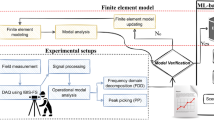Abstract
Most low-resolution radar systems, especially ground surveillance radar systems, work at relatively low pulse repeat frequency (PRF) and with short time-on-target (TOT) (duration in scanning). Low PRF leads to Doppler ambiguity and short TOT results in low Doppler resolution, which poses a problem to target classification with low-resolution radar based on the jet engine modulation (JEM) characteristic of radar echo. From the pattern classification viewpoint, we propose a method of using dispersion situations of JEM eigenvalue spectra to categorize aeroplanes into three kinds, namely turbojet aircraft, prop aircraft and helicopter. We analyze the mathematical model of JEM echoes consisting of a series of line spectra and regard them as a sum of several series of harmonious waves. Classification features can be extracted based on the harmonious wave sum model. Some schemes for extracting features from echoes within or between pulses are proposed. Low-dimensional features are extracted to reduce computation burden. Our methods do not compensate for the fuselage echoes and are insensitive to the variation of fuselage Doppler. The feasibility of our methods is demonstrated by simulation experiment.
Similar content being viewed by others
References
Ghadaki H, Dizaji R. Target track classification for airport surveillance radar (ASR). In: Wu S J, eds. IEEE Conference on Radar 2006. Beijing: IEEE, 2006. 24–27
Zhu Z F, Ding J J. Extraction of JEM signature based decomposing the return’s amplitude and phase (in Chinese). J Air Force Radar Acad, 2006, 20: 21–24
Leung H, Wu J. Bayesian and Dempster-Shafer target identification for radar surveillance. IEEE Trans Aerospace Electron Syst, 2000, 36: 432–447
Pouliguen P, Lucas L, Muller F, et al. Calculation and analysis of electromagnetic scattering by helicopter rotating blades. IEEE Trans Antenna Propag, 2002, 50: 1193–1408
Bell M R, Grubbs R A. JEM modeling and measurement for radar target identification. IEEE Trans Aerospace Electron Syst, 1993, 29: 73–87
Piazza E. Radar signals analysis and modellization presence of JEM application in the civilian ATC radars. Aerospace Electron Syst Mag, 1999, 14: 35–40
Martin J, Mulgrew B. Analysis of the theoretical radar return signal form aircraft propeller blades. In: The Record of the IEEE International Conference Radar-90. New York: IEEE, 1990. 569–572
Yang S, Yeh S. Electromagnetic backscattering from aircraft propeller blades. IEEE Trans Magn, 1997, 33: 1432–1435
Martint J, Mulgrew B. Analysis of the effects of blade pitch on the radar return signal from rotating aircraft blades. In: International Conference Radar 92. London: IET, 1992. 446–449
Elshafei M, Akhtar S, Ahmed M S. Parametric models for helicopter identification. IEEE Trans Aerospace Electron Syst, 2000, 36: 1242–1252
Melendez G J, Kesler S B. Spectrum estimation by neural networks and their use for target classification by radar. In: International Conference on Acoustics, Speech, and Signal processing 1995. New York: IEEE, 1995. 3615–3618
Moses R L, Carl J W. Autoregressive modeling of radar data with application to target identification. In: Proceedings of the 1988 IEEE National Radar Conference. New York: IEEE, 1988. 220–224
Pellegrini-S P F, Pardini C S. Radar signals analysis oriented to target characterization applied to civilian ATC radar. In: International Conference Radar 1992. London: IET, 1992. 438–445
Ding J J, Zhang X D. Studies of modulation characteristics of propeller aircraft returns in the LRR (in Chinese). J Electron Inf Tech, 2003, 25: 460–465
Ding J J, Zhang X D. Jet engine nodulations ignatures of propeller aircraft in air-defense radar signals (in Chinese). J Tsinghua Univ Sci Tech, 2003, 43: 418–421
Stove A. A Doppler-based target classifier using linear discriminants and principal components. In: The Institution of Engineering and Technology Seminar on High Resolution Imaging and Target Classification. London: IET, 2006. 171–176
Jahangir M, Pointing K M, O’Loghlen J W. A robust doppler classification technique based on hidden markov models. In: IEEE Radar 2002. New York: IEEE, 2002. 162–166
Jahangir M, Ponting K M, O’Loghlen J W. Correction to Robust Doppler classification technique based on Hidden Markov models. IEE Proceed Radar Sonar Navigat, 2003, 150: 387
Ji H, Li J, Xie W. Bispectrum based radar target classification. In: Fourth International Conference on Signal Processing Proceedings. New York: IEEE, 1992. 419–422
Xu Z, Zhang K Y, Lu L. Fast algorithms of Toeplitz matrice (in Chinese). Xi’an: Northwest Polytechnic University Press, 2006. 212–255
Wang G P, Bao C C, Zhang P. Low bit rates waveform interpolation speech coding based on singular value decomposition (in Chinese). Acta Electron Sin, 2006, 34: 135–139
Duda R O, Hart P E, Stork D G. Pattern Classification. 2nd ed. New York: John Wiley and Sons, 2001. 259–264
Andric M, Durovic Z, Zrnic B. Ground surveillance radar target classification based on fuzzy logic approach. In: International Conference on Computer as a Tool. New York: IEEE, 2005. 1390–1392
Bullard B D, Dowdy P C. Pulse doppler signature of a rotary wing aircraft. Aerospace Electron Syst Maga, 1991, 36: 28–30
Yoon S, Kim B, Kim Y. Helicopter classification using time-frequency analysis. Electron Lett, 2000, 36: 1871–1872
Linde G. Use of wideband waveforms for target recognition with surveillance radars. In: The record of IEEE International Radar Conference 2000. New York: IEEE, 2000. 128–133
Author information
Authors and Affiliations
Corresponding author
Rights and permissions
About this article
Cite this article
Chen, F., Liu, H., Du, L. et al. Target classification with low-resolution radar based on dispersion situations of eigenvalue spectra. Sci. China Inf. Sci. 53, 1446–1460 (2010). https://doi.org/10.1007/s11432-010-3099-5
Received:
Accepted:
Published:
Issue Date:
DOI: https://doi.org/10.1007/s11432-010-3099-5




